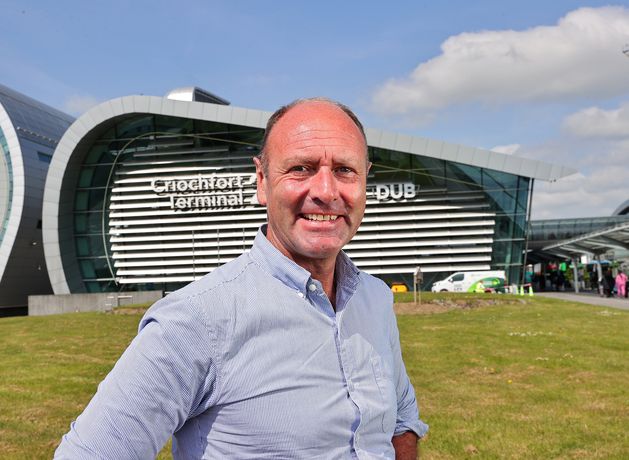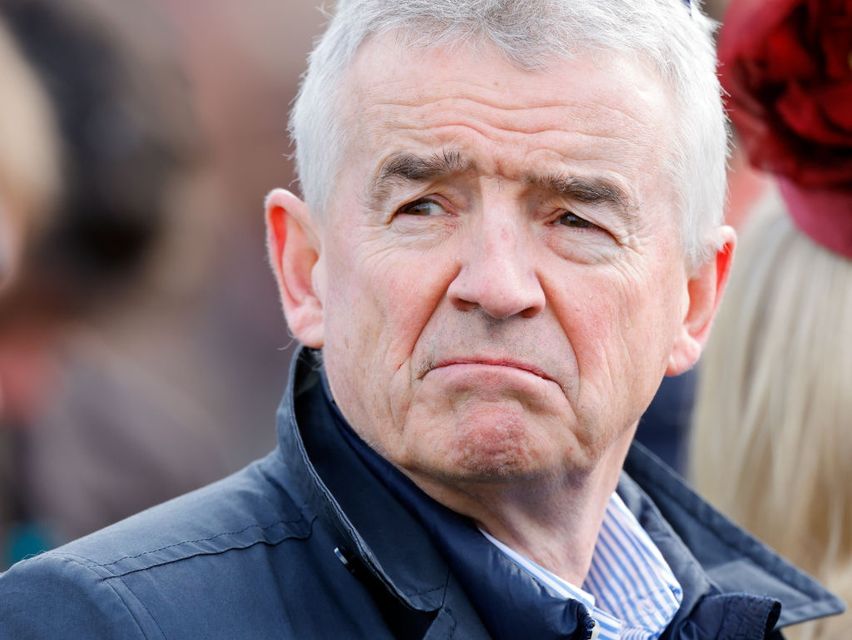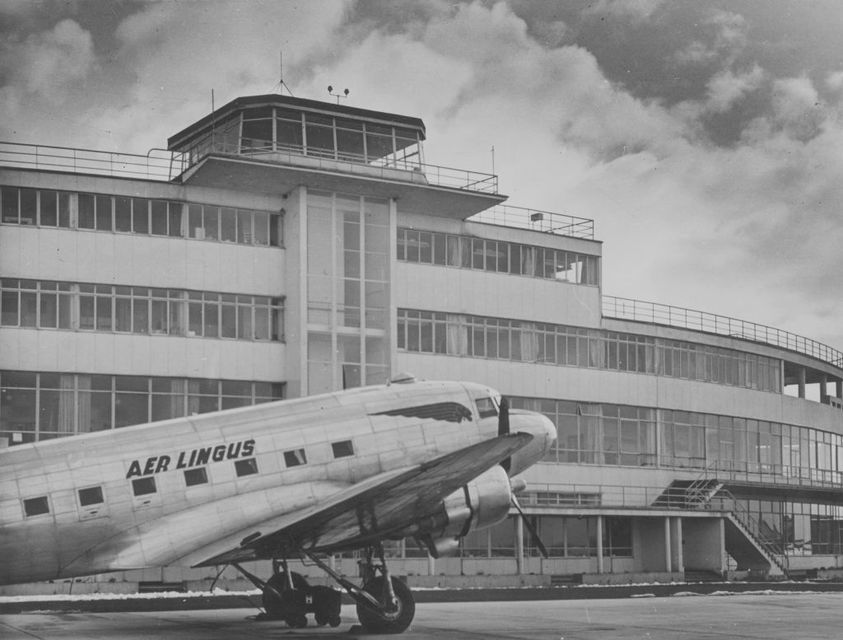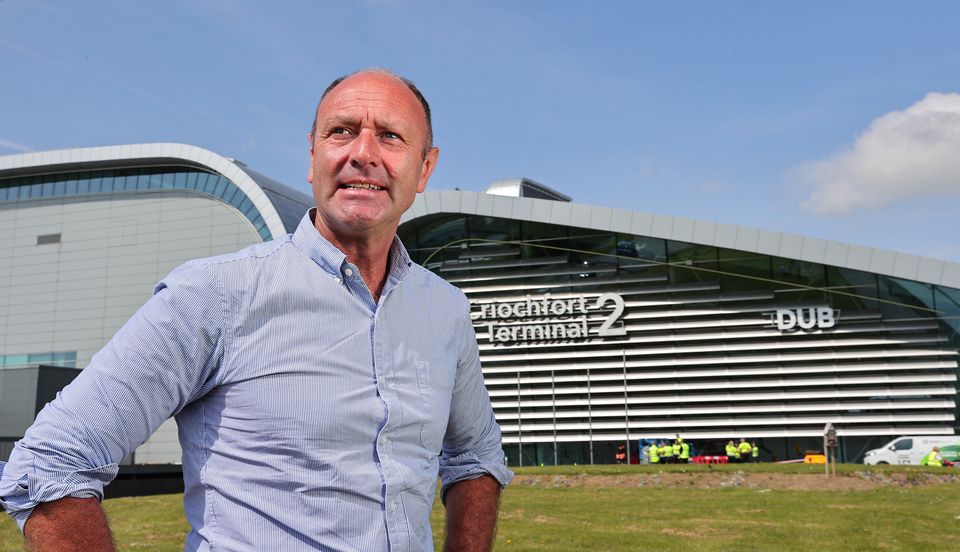These days Jacobs is the DAA chief executive, and his office – a glazed corner in the state-owned company’s swish new Dublin Airport Central development – has a panoramic view of the airport.
You can see the two terminals, the busy runway behind, the half-built new Sofitel, and, further in the distance, a collection of older buildings that Jacobs hopes to demolish to make way for new passenger piers.
“I remember we used to walk by that Aer Lingus office,” he says with a laugh, pointing towards the airline’s old personnel and catering building, “and always give them the finger.”
He admits that he has brought a “take-no-shit” attitude from Ryanair. But, he says, it is in his DNA, rather than a strategy he has deployed since taking the top job at DAA in January 2023.
“I would be sticking my elbows out, because I think we’ve taken shit in the past – and I think we now need to look after ourselves and do what’s right for our business.”
Everyone at Ryanair would have an ambition to succeed Michael
The ongoing war of words he is engaged in with Fingal County Council – which has included legal wrangling and planning enforcement actions – is actually healthy, he says.
“I don’t think there’s anything wrong with a local authority and a semi-state having a go at each other. I don’t think we’re at each other’s throats yet. But we are standing up for what we’ve been asked to do by our shareholder, which is to grow connectivity for Ireland.”
He says the DAA cannot do that, unless airport planning decisions are made faster.
“We have a very capable planning team here. They’ve got their planners and we’ve a different point of view. And we’re not afraid to express it.
” Planners can get it wrong. They are not infallible. They keep moving the goalposts – and that’s why we’re at this dead end.
“I know it looks like we’re fighting everybody. It definitely does. Are we? I don’t think so.”
They are. He doesn’t deny that the DAA’s relationship with the Government is perhaps the uneasiest one within the semi-sector portfolio – and he’s unapologetic about it.
“We’re high performing,” he says, crossing his legs to reveal a dazzling pair of pink socks beneath his jeans.
“We’ve had two record years, back to back. Yeah, we’re sticking our elbows out – and I’m comfortable with us having an uneasy relationship – because of our ambition and because we are really, really performing quite well.
“That’s healthy tension. We are a highly commercial organisation and I want to be the best semi- state. And I want to be one of the best airport and retail groups in aviation. We’ll push hard and fight our corner to do that.”
He would like a longer leash from the Government to achieve his ambitions. He wants the Department of Transport to sign off on all of DAA’s investment decisions and then leave them to get it all done.
His ultimate long-term goal is to put in place everything needed so that Dublin can handle 60 million passengers.
“I don’t want to leave this job until we’ve got the planning application for 60 million approved. That will not require a third terminal. It will need both terminals to be bigger – with new piers, including new remote piers on the western side, accessed via a tunnel.”
That, he says, is what is required to make Dublin truly world-class.
“We’re working on the 60 million master plan and that’s what we should be talking about, not the passenger cap. Aviation drives connectivity. It drives tourism and business. We should just get on and build it.
“I would love this to be a world-class airport. We’ve got a world-class team. But it’s not a world-class airport yet. We need to be able to build.”
Airlines are interested in new long-haul routes to Dublin from Sao Paulo, Delhi, Shanghai, Bangkok, Cape Town and Singapore, he says.
“There are 100,000 Brazilians living here and there’s a big Indian community too. It’s a no-brainer. But we’ve no connectivity to South America or India, and limited connectivity to China.”
But the debate over Dublin’s annual passenger cap of 32 million – now a “zombie” cap because the courts have effectively set it aside – has spooked potential new carriers.
“I’ve met airlines who could operate those routes, but they tell us they’re not going to apply for a slot because of the cap situation. Airlines want certainty before they invest in a new market.”
Ryanair boss Michael O’Leary. Photo: Getty
Jacobs is no stranger to achieving big numbers in aviation. During his seven years at Ryanair, it grew from 80 million passengers to 150 million.
“Ryanair was epic. Michael O’Leary is incredible, the best aviation CEO in the world. Learning from someone like that was great. Ryanair is famed for its low-cost approach, but its ‘keep it simple’ approach is just as important.”
During his time at Ryanair, he was sometimes tipped as a potential successor to O’Leary.
“Everyone who works there would have an ambition to succeed Michael,” he says. “But he is 60-odd now, and still at the top of his game.
“I left, in the end, because I felt I’d done my best work there. I wanted to do something different. I knew I wasn’t going to be the CEO – so it’s good to go and do something else.”
When Jacobs joined DAA, the operation was in (or, at least, recovering from) a post-Covid crisis. Many long-time staff had departed on generous severance schemes, leaving huge gaps.
New hires, particularly in security, had been hard to come by – and passengers had faced sometimes chaotic scenes the previous summer.
“When I started that January, I knew the first thing after the summer wobbles in 2022 that had to be done was to come out early and reassure the travelling public that it was going to be fine and that they could focus on booking their holidays.”
A retailer by heart rather than an operational guy, he nevertheless focused entirely on hiring and on the operation for the first six months.
“I understood, that if you can get people through security with a smile on their face – preferably in half the time they think it’s going to take – then they will be really happy.”
Happy customers equals more sales in duty free.
“It’s those simple things. The airport is an opportunity-rich environment, but we had to get that core processing right. It’s that factory element… have the resources and get the throughput on the lane. We haven’t looked back since.”
In recent weeks he has announced a €200m investment at DAA’s other big – and fast growing – Irish asset, Cork Airport. The mood there is different to Dublin and the airport investment is just part of a wider push to turn Cork into a city of a million people, he says.
“We have a great relationship with the stakeholders there,” he says.
I don’t think Fingal is incompetent, but I think it’s wrong that our applications go into Fingal
In the capital it’s different.
“Yeah, it’s tense with Fingal. I don’t want to fight anybody, including Fingal. But the issue around planning…
“I think we’re fighting that one for Ireland. And it’s a fight worth having. It’s no longer about getting the cap lifted. It’s about getting faster planning.”
The DAA has three key applications in – and for now, all are in limbo.
One would simply lift the cap, the second seeks permission for the demolition and rebuilding job that Jacobs says is required to allow Dublin handle 40 million passengers. A third planning issue revolves around night-time flights and the operation of the new runway.
Without clarity on these planning issues, Dublin Airport simply will not be able to handle that growing number of passengers.
Jacobs wonders if the planning department in Fingal can, or will, deliver what’s needed, in time to allow DAA build the new piers it needs.
“I know some people say you can’t question the system. But hang on, this isn’t a Kafka novel. It’s an island of five million people. And we created the system.
“You can lift the lid and you can change things. We’re all entitled to question the system if the system is producing wrong and very slow answers. We are going to be at 36 million passengers this year.”
Jacobs believes that putting applications for airport infrastructure through a local authority planning office makes no sense. He says it should instead be dealt with directly by An Bord Pleanála as strategic infrastructure.
The Airport Noise Competent Authority (Anca), which was set up under the auspices of Fingal Co Council as an independent entity, should be moved to the Irish Aviation Authority, he says.
“I don’t think Fingal is incompetent, but I think it’s wrong that our applications go into Fingal – because this is strategic infrastructure. I think Dublin Airport should be reclassified strategic infrastructure.”
That, he admits, would require legislative change.
“I don’t think we are talking pages and pages of legislation. It’s pretty simple. It shouldn’t take years,” he says. “So it’s over to the Government on that.
“If we are waiting for legislative change, then it could be another two-and-a-half years before we get the green light on planning from Fingal and then An Bord Pleanála, and then it will be another 18 to 24 months before we get stuff built.”
That, he says, would be “a shame and a loss” for Ireland.
“We’re going to do over 36 million passengers in 2025. The max we can take operationally is 38 to 39 million. So if we can’t open new capacity before 2030, there will be a period of two to three years where we will absolutely be turning business away.”
Allowing growth to continue under those circumstances would land the airport back in a situation similar to the chaotic summer of 2022.
“Do we want to drop the standards of the airport? Do we want to see people queuing? Do we want to see an operational mess because it’s full to the brim?
“No, we don’t – and we would have to put limits on it. It won’t be a runaway train to a number that we are not comfortable to operate. But that would mean us putting an operational cap ourselves at the airport.”
Alternatively, he says, if the Government designates the airport as strategic infrastructure, expansion can happen much more quickly.
Of course, the planning mess in which the DAA finds itself is ultimately largely of its own making.
Jacobs defends his predecessors in the office. He argues that DAA did apply to Fingal to have the cap removed in 2019 but was advised by the local authority and others that this could not be handled at the same time as the application for the new north runway.
The Covid lockdown saved it from hitting a capacity crunch sooner.
“If you had your time again, you would say: ‘No, sorry guys, we’ve got to do both,’” he says.
“I remember being in Ryanair 10 years ago, doing a press conference and telling DAA: ‘You need to get on and start planning.’
“We had added an extra million passengers in Ryanair in both 2014 and 2015 and Dublin had grown to 31 million.
“Mathematically, the time frame to apply for 40 million is when you’re at 27 or 28 million – not when you’ve hit 31 million.”
He declines to blame his predecessors in the job for not tackling the looming planning issues.
“Look, hindsight is a wonderful thing for any CEO. We should have applied for planning 10 years ago.
“I think this is an Irish thing. The lastminute.com way to manage critical infrastructure isn’t the way to do it. There was a little bit of mañana in the approach for everybody here…the local authority, the department, everybody.”
Some people are arguing for a complete rethink.
Businessman Ulick McEvaddy leads a consortium that owns a large site west of the airport and wants to build a third terminal there. Jacobs has previously discussed with him a purchase of the strategic site by the DAA.
“We’re owned by the State, and we’re proven – and look at the difficulties we’re having. They’ve a much steeper hill to climb. They’d be better off engaging with us on reaching a fair and good price.
“I talked to him a few months ago. He wants to sell it at X price, we want to buy a part of it at Y price. So we’d be interested in a portion of the lands at the right price. I’m sure we’ll talk again.”
An Aer Lingus plane at what was then called Collinstown Airport. Photo: Getty
Meanwhile, DAA has snapped up its own landbank in the area, including a famous old pub.
“We bought the Boot Inn recently,” he says. It was once the venue for Jets nightclub, a legendary hangout for airport staff, where manys an airport marriage began.
“And a few ended maybe,” quips Jacobs. “I was floating the idea with some members of staff of bringing Jets back on a Friday night.”
“I’m going to go and take a look. You could do interesting things there, maybe a viewing area.”
Jacobs grew up in Montenotte in Cork, the youngest of four. His father was a builder and his mother worked at home.
“I worked for my dad on the building sites during the summers. That was great. But they wanted us all to go to college, so I did a BComm in UCC.”
He took a part-time job stacking shelves in Dunnes Stores in Ballyvolane, where he got his first taste for retail – and he loved it.
Jacobs also grew up with a strong Catholic faith, which he retains. He was an altar boy until he was 18.
“I still go to mass once a week. It’s something I believe in. But I don’t shove my faith down anyone’s throat. I’m Catholic but I believe that women should be priests, that priests should be able to marry, and if they want to marry men, they should marry men.”
Look at Ryanair, it’s a retailer… so much of that revenue is just good retailing
After college he took an internship with Proctor & Gamble in the UK, so as to “wear suits and make money”, but retail soon drew him back.
He joined Tesco, rising to marketing director before joining Ryanair in 2013.
”I was always fascinated with how people move around a shop and the decisions they make.”
“This,” he says, pointing out the window again, “is a big shopping mall attached to a piece of tarmac.
“And look at Ryanair, it’s a retailer and so much of that ancillary revenue is just good retailing.”
This week, DAA is launching an app that’ll offer car parking, lounges and fast-track access in a similar way to the Ryanair model.
“I’m quite involved in that, because I’ve done it before. Once the operation is running well, then it’s about just making more money from every single passenger.”
DAA also owns a substantial international operation running 30 duty free stores around the world and running three airports in Saudi Arabia, where it hopes to expand further. It is also currently looking at a potential airport contract in the UK.
“It would be great to run more airports,” he says. “We’re good at it.”
The company is currently looking at a few projects in Saudi Arabia and one in the UK.
“Could we run Liverpool or Bristol or Glasgow from here? Absolutely.”
But Jacobs believes the company name – changed from Dublin Airport Authority into the all-small letter daa acronym in a previous branding exercise – no longer works.
“When you are still explaining the name then there’s something wrong. And this company is about more than just Dublin – and the word ‘authority’ is kind of Orwellian. We’re not a regulator.”
But he says he has no intention of paying a marketing agency for a new name – and is instead running a staff competition.
“I entered two suggestions myself, but they’re top secret,” he says.
As with much else at the DAA, we will have to wait and see.
DAA chief executive Kenny Jacobs. Photo: Gerry Mooney
Curriculum Vitae
Name: Kenny Jacobs
Position: CEO of DAA
Age: 51
From: Montenotte, Cork
Lives: Sandymount, Dublin 4
Family: Married to Muireann with two teenagers, Harvey and Hannah
Favourite hobby: Playing drums (though he has swapped his heavy metal kit for a jazz kit), cooking, walking the dog
Favourite book: Zen and the Art of Motorcycle Maintenance by Robert Pirsig. Or anything by military historian Antony Beevor
Favourite movie: The Godfather Part III
Favourite holiday destination: Ko Samui in Thailand
Business lessons
What advice would you give a young person preparing for life after the Leaving Cert?
“Set up your own website and try to sell something from it. Learn Mandarin. Travel.”
#happy #elbows #Kenny #Jacobs #battles #million #passengers #year #worldclass #Dublin #Airport










